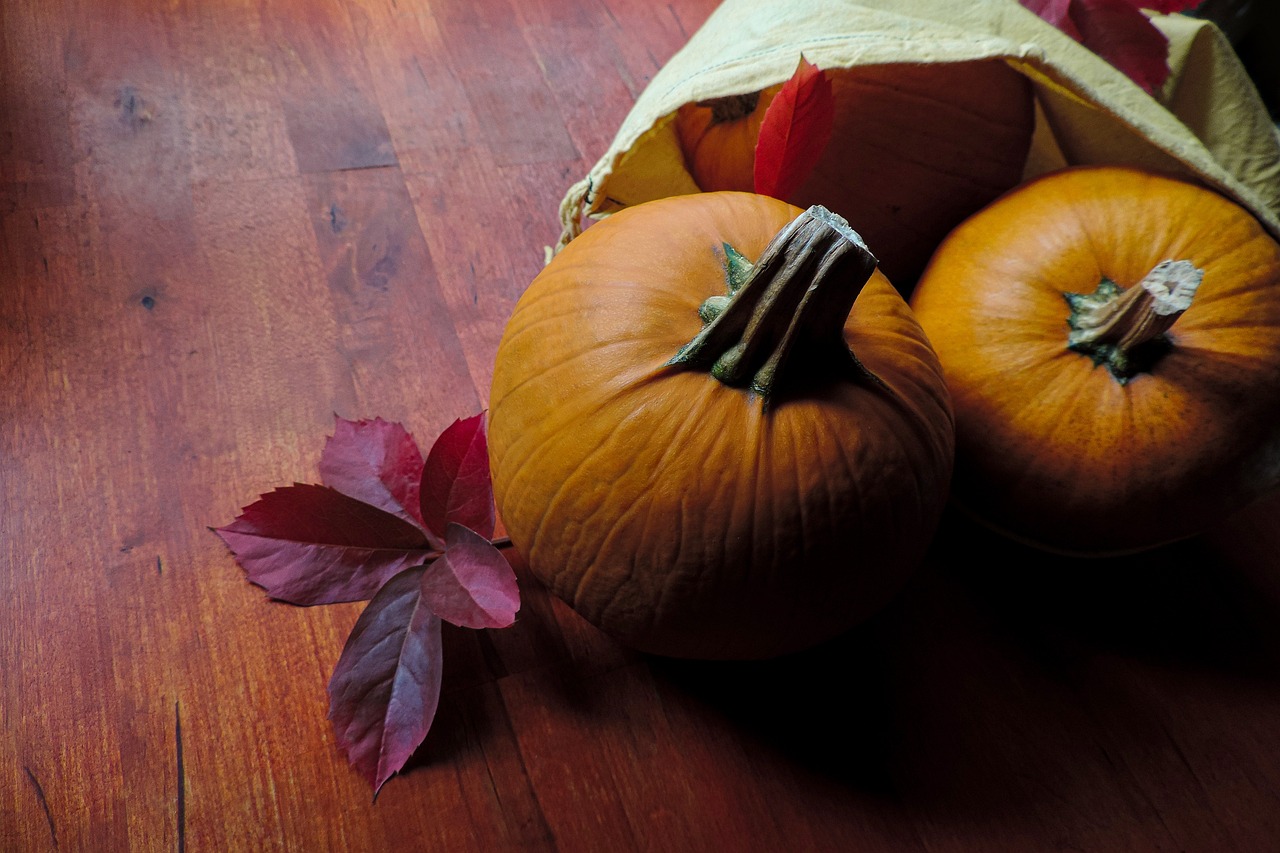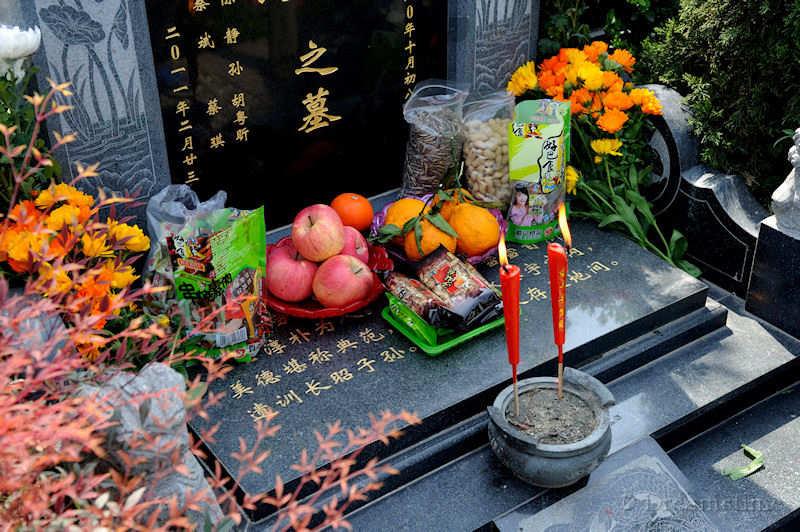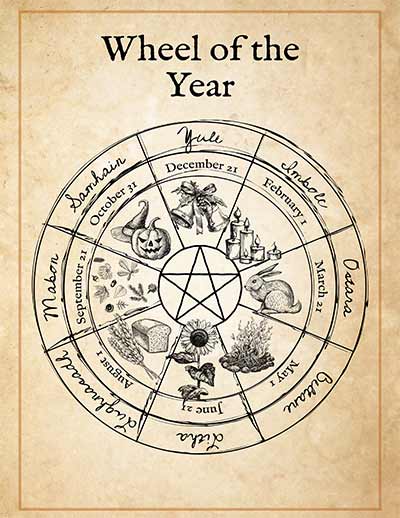Table of Contents
Samhain, pronounced “sow-in,” is a sacred and pivotal time on the modern Wiccan calendar. As one of the eight Sabbats that make up the Wheel of the Year, Samhain holds a special place in the hearts of contemporary witches. This article explores how modern Wiccans celebrate and honor the ancient traditions of Samhain in today’s world.
Samhain, often pronounced as “sow-in,” is an enchanting and significant moment within the modern Wiccan calendar, representing a harmonious blend of ancient traditions and contemporary spiritual practices. As one of the eight Sabbats that form the intricate Wheel of the Year, Samhain occupies a unique and cherished position among contemporary witches. In this article, we embark on a journey to unravel the deep-rooted significance of Samhain for modern Wiccans and delve into the ways they celebrate and honor this sacred occasion in the context of today’s world.
At its core, Samhain represents a pivotal point in the annual cycle, marking the transition from the bountiful days of autumn to the introspective depths of winter. It is a liminal time when the veil between the physical and spiritual realms is believed to be at its thinnest, allowing for heightened spiritual connections and communication with ancestors and departed loved ones.
One of the central themes of Samhain is the acknowledgment of the cycle of life, death and rebirth. Wiccans see this time as an opportunity to reflect on the past year, honor those who have passed away and prepare for the spiritual and personal growth that the coming winter months will bring.
Modern Wiccans celebrate Samhain in a variety of ways that honor both tradition and personal spirituality. Rituals often involve lighting candles, creating altars adorned with seasonal symbols like pumpkins and apples and casting circles to create sacred spaces. Ancestral veneration plays a significant role, with practitioners setting a place at their dinner tables for departed ancestors and lighting candles in their memory.
During Samhain, divination practices are also prevalent, with tarot card readings, scrying and other forms of fortune-telling used to gain insights into the future and seek guidance from the spirit world. The thinning of the veil is believed to facilitate clearer communication with spirits, making this a particularly auspicious time for such practices.
Modern Wiccans may also engage in spellwork and rituals that focus on protection, banishing negativity and personal transformation. The energy of Samhain is seen as a powerful catalyst for change and personal growth.
Community and connection are essential aspects of Samhain celebrations among modern Wiccans. Covens and individuals often gather for communal rituals, feasting and storytelling. These gatherings foster a sense of unity and shared purpose, reinforcing the bonds of the Wiccan community.
In today’s fast-paced world, Samhain serves as a poignant reminder to pause, reflect and connect with the spiritual and ancestral aspects of life. It provides modern Wiccans with an opportunity to honor tradition while adapting its timeless wisdom to address the needs and aspirations of contemporary life. Samhain continues to be a cherished and transformative celebration that brings Wiccans closer to nature, the spirit world and the essence of their own spirituality.
If you’d like to dive deeper into this subject, there’s more to discover on this page: Halloween isn’t about candy and costumes for modern-day pagans …
A Brief Overview of Samhain
Before delving into the modern practices, let’s briefly understand the historical and spiritual significance of Samhain. Traditionally, Samhain marked the end of the harvest season and the beginning of winter. It was a time when the veil between the physical world and the spirit world was believed to be at its thinnest, allowing for easier communication with the deceased and other spiritual entities.
In modern times, Samhain has evolved into a festival of remembrance, honoring the cycles of life, death and rebirth and celebrating the harvest’s bounty.
Before exploring modern Samhain practices, it’s essential to delve deeper into the historical and spiritual roots of this ancient celebration. Understanding the origins and significance of Samhain provides a profound context for the contemporary interpretations of this sacred holiday:
Ancient Agricultural Significance: Samhain, pronounced “sow-in,” was an integral part of the Celtic agricultural calendar. It marked the culmination of the harvest season, a time when communities gathered their final crops and prepared for the onset of winter. The reverence for nature and the cycles of life are deeply ingrained in Samhain’s historical origins.
Thin Veil Between Worlds: Samhain was believed to be a pivotal moment in the wheel of the year when the veil separating the physical realm from the spirit world grew thin. This liminal state allowed for increased interaction between the living and the deceased. Rituals and ceremonies were performed to honor and seek guidance from departed loved ones and ancestral spirits.
Fire and Protection: Bonfires, a prominent aspect of Samhain celebrations, served both practical and spiritual purposes. On a practical level, these fires helped ward off the encroaching darkness and provided warmth. Spiritually, they were seen as beacons to guide spirits and as symbols of protection against malevolent forces.
Reverence for Ancestors: Samhain was a time of paying homage to ancestors and acknowledging their role in shaping the present and future. Many customs revolved around setting a place at the table or leaving offerings for the departed, reinforcing the enduring connection between generations.
Cycles of Life and Death: Samhain embodies the concept of cyclical renewal. It acknowledges that death is a natural part of the life cycle and that, through death, new life can emerge. This profound understanding of the interconnectedness of life and death remains a central theme in modern Samhain practices.
Modern Revival: In contemporary times, Samhain has experienced a revival among Pagan and Wiccan communities. It has evolved into a time of reflection, introspection and spiritual exploration. Modern practitioners embrace the holiday’s historical roots while adapting its rituals to suit their individual beliefs and needs.
Harvest Celebration: While Samhain is often associated with Halloween, it is, at its core, a celebration of the harvest’s bounty. Modern Samhain feasts frequently feature seasonal foods like apples, pumpkins and grains, honoring the agricultural heritage of the holiday.
Personal Transformation: Samhain encourages personal growth and transformation. It invites individuals to confront their fears, release the past and embrace change. Rituals often focus on shedding old habits and embracing new beginnings.
Community and Connection: Samhain fosters a sense of community and connection. Modern celebrations may include group rituals, storytelling and communal meals, allowing participants to share their experiences and deepen their spiritual bonds.
In summary, Samhain, with its historical roots in agriculture and spirituality, remains a time of reflection, remembrance and reverence for the cycles of life and death. While modern interpretations vary widely, the essence of Samhain continues to honor the profound connection between the natural world, the spirit world and the enduring legacy of our ancestors.
To expand your knowledge on this subject, make sure to read on at this location: Halloween isn’t about candy and costumes for modern-day pagans …

Samhain in Contemporary Wicca
Modern witches, especially those following the Wiccan tradition, have embraced Samhain as a time for reflection, connection and celebration. Here’s how contemporary Wiccans observe this sacred Sabbat:
Modern witches, especially those following the Wiccan tradition, have not only embraced Samhain but also infused it with their own unique practices and interpretations. Here’s a deeper look into how contemporary Wiccans observe this sacred Sabbat and the meaningful elements they incorporate:
Ancestor Veneration: Contemporary Wiccans often place a strong emphasis on ancestor veneration during Samhain. They create altars adorned with photographs, mementos and offerings to honor and connect with their departed loved ones. This practice fosters a sense of continuity and respect for those who have come before, bridging the gap between the living and the deceased.
Meditation and Reflection: Samhain provides a poignant opportunity for meditation and introspection. Wiccans take time to reflect on the past year, acknowledging their achievements, losses and personal growth. It’s a period for contemplating life’s cyclical nature and the inevitability of change.
Divination and Oracle Work: Many Wiccans engage in divination practices during Samhain to seek insights into the future or gain guidance from the spirit world. Tarot readings, scrying and other forms of divination are common, as the thinning of the veil is believed to facilitate communication with the unseen realms.
Rituals and Spellwork: Samhain rituals often involve spellwork focused on protection, banishing negative influences and setting intentions for the coming year. Wiccans harness the heightened spiritual energy of this season to perform rituals that align with their personal goals and desires.
Feasting and Communal Gatherings: Samhain is a time for feasting and communal gatherings within the Wiccan community. Sharing a meal, telling stories and participating in rituals together strengthen bonds and create a sense of unity among practitioners.
Nature Connection: Many contemporary Wiccans also emphasize their connection to nature during Samhain. They may take nature walks, collect seasonal herbs or engage in eco-friendly practices as a way of aligning themselves with the rhythms of the Earth and the changing of the seasons.
Honoring the God and Goddess: Samhain is seen as a time when the God descends into the underworld and the Goddess transitions into her crone aspect. Wiccans pay homage to both aspects of the divine during this Sabbat, recognizing the cycle of life, death and rebirth.
Candle Lighting and Bonfires: The lighting of candles, lanterns and bonfires is a common practice during Samhain. These sources of light symbolize the guiding presence of spirits and ancestors and serve as a beacon for their return.
Costumes and Masks: Some Wiccans incorporate the tradition of wearing costumes and masks during Samhain to symbolize their willingness to cross the boundary between the living and the spirit world. This practice adds an element of playfulness and mystique to the festivities.
Community Service: In the spirit of giving back, some Wiccan communities engage in charitable activities during Samhain to support those in need. This reflects the Wiccan belief in the interconnectedness of all living beings and the importance of fostering compassion and goodwill.
In essence, contemporary Wiccans have beautifully adapted and expanded upon the ancient traditions of Samhain. While they continue to honor its core themes of reflection, connection and celebration, they also infuse it with their own spiritual insights and practices, creating a rich and meaningful observance that resonates with their modern beliefs and values.
Should you desire more in-depth information, it’s available for your perusal on this page: Samhain – Traditions, Halloween, Wicca | HISTORY

Ancestor Veneration
Ancestor veneration is a cornerstone of Samhain celebrations in contemporary Wicca. Many Wiccans create ancestor altars adorned with photographs, candles and offerings. These altars serve as a focal point for connecting with and honoring their ancestors. It’s a time to express gratitude for the wisdom and guidance passed down through generations.
In contemporary Wicca, Samhain’s significance is magnified by the deep reverence for ancestral connections. Ancestor veneration, an age-old practice, takes center stage during these celebrations, weaving a profound tapestry of heritage and spirituality.
Wiccans pour their hearts into crafting intricate ancestor altars, carefully selecting mementos, photographs and symbolic items that resonate with their family’s lineage. Lit candles flicker in the dimly lit space, casting a warm, inviting glow that beckons ancestral spirits to draw near.
These sacred altars become portals to the past, serving as a bridge between the living and the departed. As Wiccans stand before these altars, they embark on a journey through time, immersing themselves in the stories, wisdom and traditions of their forebears. It’s a poignant reminder that the threads of the past continue to weave into the fabric of the present.
Offerings, carefully chosen for their significance, are placed on these altars as tokens of respect and gratitude. It’s a way of reciprocating the love and guidance that has been generously bequeathed to them by those who came before. Fruits, flowers and libations become symbols of appreciation for the enduring legacy left behind.
Samhain’s ancestor veneration is not merely a ritual; it’s a heartfelt embrace of the intergenerational bond that transcends time and space. It’s a moment of reflection on the profound influence of ancestors, not just in shaping family histories but also in nurturing the spiritual paths of the living.
As the veils between realms thin during Samhain, these altars serve as a conduit for communication and communion. It’s a time for listening, for receiving whispered wisdom from the other side. Through these rituals, Wiccans celebrate the beautiful continuity of life, love and tradition that flows seamlessly from one generation to the next.
Looking for more insights? You’ll find them right here in our extended coverage: How To Celebrate Pagan Samhain Instead of Halloween

Rituals and Spellwork
Samhain rituals and spellwork are integral to Wiccan celebrations. These can vary widely but often involve divination, protection spells and rituals to release what no longer serves one’s highest good. Samhain is considered an auspicious time for divination, as the thinning veil is believed to facilitate clearer communication with the spirit world.
Samhain rituals and spellwork hold a central place in the practice of Wicca and other pagan traditions. They mark a time of deep spiritual significance and provide an opportunity to engage with the energies of transformation, introspection and connection with the spirit world. Let’s delve further into the rich tapestry of Samhain rituals and spellwork:
Divination and Ancestral Communication: Samhain is often regarded as the pinnacle of the year for divination. With the veil between the worlds at its thinnest, practitioners believe it is easier to connect with the spirit realm, seek guidance from ancestors and gain insights into the future. Tarot readings, scrying with crystal balls or mirrors and pendulum work are common divinatory practices during this time.
Protection Spells: As the transition into winter commences, many Wiccans and pagans use Samhain as an occasion to cast protection spells. These spells are designed to safeguard against negative energies, unwanted influences and malevolent forces that may be more active during this liminal period.
Release and Transformation: Samhain embodies the spirit of transformation and letting go. Rituals and spells focused on releasing what no longer serves one’s highest good are a prevalent theme. Participants may symbolically cast away burdens, bad habits or negative emotions into a sacred fire or flowing water, signifying their willingness to embrace personal growth and renewal.
Ancestor Altars and Offerings: Creating ancestor altars is a cherished Samhain tradition. These altars are adorned with photographs, mementos and offerings to honor departed loved ones. Candles, incense and food offerings are commonly placed on these altars as a way to show respect and gratitude to ancestors.
Feasting and Celebration: Samhain is a time of communal celebration and feasting. Sharing a meal with friends and fellow practitioners is a way to strengthen bonds, express gratitude for the harvest and create a sense of unity within the community.
Warding and Boundary Setting: With the boundary between worlds becoming more porous, many Samhain rituals involve setting protective boundaries or wards to ensure that only benevolent spirits are welcomed. This is done to maintain a safe and sacred space during ceremonies and spellwork.
Ancestor Invocation: Samhain rituals often include the invocation of ancestral spirits. Practitioners may recite the names of their ancestors, invite their presence and seek their guidance or blessings for the coming year.
Candle Magic: The lighting of candles holds great significance during Samhain. Black and orange candles are commonly used to represent the duality of the season—the darkness of winter and the promise of rebirth in the spring. Candle magic rituals may be performed to manifest intentions, honor the deceased or seek clarity.
Harvest Blessings: Samhain also serves as a time to give thanks for the bountiful harvest and the gifts of the Earth. Rituals may involve offering gratitude to the deities associated with agriculture and fertility.
Community Connection: Beyond the solitary practitioner, Samhain is often a time when Wiccan and pagan communities come together to celebrate, share knowledge and support one another in their spiritual journeys.
In conclusion, Samhain rituals and spellwork are multifaceted and deeply rooted in the essence of this sacred holiday. They provide a framework for introspection, spiritual connection and transformation as practitioners honor the past, embrace the present and look forward to the mysteries of the future. Through divination, protection and rituals of release and renewal, Samhain rituals offer a rich tapestry of experiences and opportunities for personal and collective growth within the Wiccan and pagan traditions.
Explore this link for a more extensive examination of the topic: Wicca – Religious Practices Religious Items

Feasting and Sharing
Feasting is a cherished aspect of Samhain celebrations in Wicca. Traditional foods like apples, pumpkins and other autumnal treats are often shared in communal gatherings. These feasts are not just about physical sustenance but also serve as a way to strengthen bonds with fellow practitioners and celebrate the bounty of the season.
In the tapestry of Samhain celebrations within Wicca, feasting emerges as a cherished and essential tradition. It’s a time when the flavors of the season come to life and the table overflows with a bounty of nature’s harvest. While feasting certainly satisfies physical hunger, its significance extends far beyond nourishment; it weaves together the threads of community, tradition and spirituality in a delightful and meaningful way.
1. Abundance of the Season:
Samhain falls during the heart of autumn when the Earth offers its final, magnificent display of abundance before the hush of winter descends. Apples, pumpkins, squashes and other seasonal delights grace the feasting table, embodying the essence of this time of year. These foods, often sourced locally, carry the rich flavors and colors of the season, connecting participants to the rhythms of the Earth.
2. Communal Gatherings:
Feasting at Samhain is rarely a solitary affair; it is a communal experience that brings people together in the spirit of unity and shared celebration. Practitioners gather with friends, family and fellow Wiccans to partake in the festivities. The act of sitting down together, sharing food, laughter and stories, strengthens the bonds within the community.
3. Honoring Ancestral Traditions:
As Samhain is a time for connecting with ancestors and the spirit world, the feasting table often includes dishes and recipes that have been passed down through generations. These ancestral foods not only honor the wisdom and heritage of those who came before but also create a sense of continuity and connection with the past.
4. Symbolism and Ritual:
The foods served during the Samhain feast often carry symbolic meaning. Apples, for example, are associated with divination and the Otherworld, while pumpkins represent the transformational magic of the season. Participants may incorporate these symbols into rituals or simply savor them as a way to deepen their connection to the spiritual aspects of Samhain.
5. Expressing Gratitude:
Samhain is a time of reflection and gratitude for the blessings received throughout the year. The feast serves as an opportunity to express thanks for the abundance of the season, the connections within the community and the guidance of the ancestors. It is a moment to acknowledge the cyclical nature of life, with its moments of both growth and harvest.
6. Ritual and Sacred Space:
Within Wiccan practice, the feasting table can also be seen as an extension of the sacred space. The act of sharing food is not only a celebration of the physical world but also a reminder of the interconnectedness of all things and the divine presence that flows through them.
In essence, feasting during Samhain in Wicca is a beautiful and multi-layered tradition. It embraces the bounty of the season, strengthens community bonds and honors ancestral wisdom. It is a reminder that even in the midst of introspection and reflection, there is joy to be found in the simple act of coming together, sharing a meal and celebrating the rhythms of the Earth. Through feasting, Wiccans not only nourish their bodies but also nourish their spirits, deepening their connection to the natural world and the sacred cycles of life.
For a comprehensive look at this subject, we invite you to read more on this dedicated page: Cultural Appropriation in Contemporary Neopaganism and Witchcraft

Honoring the God and Goddess
Samhain is a time to honor the God and Goddess in their various forms, especially the Crone aspect of the Goddess and the God as the Horned One. Wiccans may conduct rituals and ceremonies that reflect the changing aspects of the deities and the cycle of life, death and rebirth.
Samhain, at its core, is a celebration that honors the rich and intricate tapestry of the divine, embracing the diverse aspects of the God and Goddess within the framework of Wiccan spirituality. Among these divine facets, the Crone aspect of the Goddess and the Horned One as the God take center stage during this sacred time. Wiccan rituals and ceremonies conducted during Samhain are deeply rooted in the symbolism of these deities and the profound cycle of life, death and rebirth that they represent.
The Crone Aspect of the Goddess: Samhain is a moment when the Goddess is often revered in her Crone aspect. This aspect symbolizes wisdom, maturity and the culmination of life’s experiences. The Crone embodies the waning phase of the lunar cycle and represents the harvest, both of the land’s bounty and the wisdom gained through life’s journeys. Wiccans honor the Crone during Samhain for her guidance and her role as the guardian of ancestral knowledge.
The Horned One as the God: Concurrently, the God is recognized as the Horned One, a symbol of masculine energy, wild nature and the cycle of life, death and rebirth. The Horned One is often associated with the hunt, vitality and the life force that courses through the natural world. During Samhain, the God’s transition into the realm of the Ancestors is acknowledged, signifying the close of the agricultural year and the beginning of the spiritual new year.
Rituals Reflecting the Divine Aspects: Samhain rituals within Wiccan traditions are thoughtfully designed to resonate with the themes of the Crone and the Horned One. These ceremonies typically include elements such as altar decorations, invocations and symbolic representations that pay homage to the aging Goddess and the God’s journey into the realm of the Ancestors.
Ancestral Connections: Samhain is a time when the veil between the physical and spiritual worlds is believed to be at its thinnest. Wiccans often use this unique opportunity to communicate with and honor their ancestors, seeking guidance and wisdom from those who have crossed into the Otherworld. These rituals often involve the lighting of candles, the offering of food and drink and the sharing of stories and memories.
Acknowledging the Cycle of Life: Samhain rituals are a poignant reminder of the eternal cycle of life, death and rebirth. They offer Wiccans a chance to reflect on their own journeys and to recognize that death is not an end but a part of the continuous cycle of existence. This perspective encourages a deeper connection with the natural world and a profound sense of spiritual interconnectedness.
Embracing Transformation: Samhain encourages Wiccans to embrace personal transformation and growth, just as the God and Goddess embody transformation in their changing aspects. It’s a time to release what no longer serves, both spiritually and in everyday life and to make way for new beginnings and possibilities.
In essence, Samhain in Wiccan tradition is a celebration of the divine in all its facets, a profound acknowledgment of the wisdom and vitality represented by the Crone and the Horned One. It serves as a bridge between the past and the future, a time to honor the ancestors and a reminder that the cycle of life continues to turn, offering opportunities for renewal and spiritual evolution. Samhain’s rituals and ceremonies are a testament to the enduring connections between humanity, the divine and the natural world, woven together in a tapestry of reverence and celebration.
If you’d like to dive deeper into this subject, there’s more to discover on this page: Cultural Appropriation in Contemporary Neopaganism and Witchcraft

Meditation and Reflection
Many modern witches use Samhain as an opportunity for deep introspection and meditation. It’s a time to assess personal growth, release what no longer serves one’s spiritual journey and set intentions for the future. Samhain’s energy encourages self-discovery and transformation.
Many modern witches find Samhain to be an incredibly potent and spiritually charged time, making it ideal for profound introspection and meditation. Beyond its associations with Halloween and harvest festivals, Samhain holds a unique and sacred place in the hearts of those who follow nature-based or pagan spiritual traditions. Here are some additional insights into how Samhain can be a catalyst for personal growth and transformation:
The Thin Veil: Samhain is often considered a time when the veil between the living and the spirit world is at its thinnest. This perceived closeness to the otherworldly realms can make it easier for individuals to tap into their intuition, connect with spirit guides and gain insights into their life’s purpose.
The Cycle of Life and Death: The natural world provides a vivid backdrop to the themes of Samhain. As leaves fall, plants wither and the Earth goes into a period of rest, it reminds us of the cyclical nature of life and death. This symbolism encourages us to contemplate the impermanence of existence and the importance of living authentically.
Releasing and Renewal: Samhain is an excellent time to release what no longer serves us. Many witches engage in rituals or spells aimed at letting go of negative habits, toxic relationships or emotional baggage. This act of release is often followed by setting intentions for the future, symbolizing a fresh start.
Ancestor Connection: As mentioned earlier, Samhain is a time when the spirits of our ancestors are believed to be more accessible. Witches may use this opportunity to communicate with their forebears, seeking guidance, wisdom or simply a sense of connection and belonging.
Shadow Work: Samhain’s energy can be harnessed for shadow work, a process of confronting and embracing the darker aspects of ourselves. This introspective journey allows individuals to heal and integrate unresolved emotions or traumas, leading to personal growth and transformation.
Ceremonial Magic: For some practitioners, Samhain rituals may involve ceremonial magic. These rituals are often designed to honor the changing of the seasons, express gratitude for the harvest and welcome the introspective energy of the season.
Community and Celebration: Samhain is often celebrated in community, whether through group rituals, gatherings or festivals. This sense of togetherness provides support and camaraderie as individuals embark on their personal journeys of transformation.
Setting Sacred Space: Preparing an altar or sacred space dedicated to Samhain can be a powerful practice. It serves as a focal point for meditation, spellwork or contemplation and it reinforces the connection to the energies of the season.
Harvesting Wisdom: Samhain encourages us to take stock of our experiences, extract lessons and wisdom from them and carry that knowledge forward as we embrace the future. It’s a time to acknowledge our growth and honor the wisdom we’ve gained.
In essence, Samhain is a rich tapestry of spiritual symbolism and energy that invites introspection, growth and transformation. For modern witches and those who appreciate its significance, Samhain provides a sacred space to delve deep within, embrace change and emerge from the darkness with renewed clarity and purpose. It’s a time to celebrate life, death and the ever-evolving journey of the soul.
You can also read more about this here: The eight Sabbats: Witch’s holidays – Grove and Grotto

Samhain and the Modern World
In today’s fast-paced world, where technology often dominates, Samhain serves as a poignant reminder of our connection to nature, the cycles of life and the spiritual world. Contemporary Wiccans have adeptly woven these ancient traditions into their modern lives, keeping the spirit of Samhain alive.
In today’s fast-paced world, where technology often dominates our lives and distances us from the natural rhythms of the earth, the celebration of Samhain stands as a profound and poignant reminder of our intrinsic connection to nature, the profound cycles of life and the ethereal realms beyond our immediate senses. Samhain urges us to pause, to look beyond the screens and devices and to embrace the deeper truths of our existence.
In this age of rapid advancements, contemporary Wiccans have demonstrated a remarkable ability to blend these ancient, time-honored traditions seamlessly into their modern lives. The essence of Samhain, with its reverence for the changing seasons, the impermanence of life and the spiritual mysteries, continues to resonate in their hearts and practices.
Amidst the bustling digital world, the celebration of Samhain encourages us to step outside, breathe in the crisp autumn air and immerse ourselves in the natural beauty that surrounds us. It beckons us to witness the leaves turning, the earth shifting and the energies evolving—a reminder that just as the seasons transform, so do the phases of our own lives.
For modern Wiccans, Samhain remains a sacred time for introspection, an opportunity to honor their ancestors and a chance to connect with the unseen realms. Whether through digital platforms or physical gatherings, they come together to share stories, perform rituals and express gratitude for the wisdom passed down through generations.
In weaving these ancient traditions into their contemporary lives, Wiccans breathe life into the spirit of Samhain. They not only honor the past but infuse it with relevance in the present, enriching their spiritual journey and fostering a deeper understanding of their place in the cosmos. Samhain, in its timeless wisdom, guides them, reminding all who partake that the ancient and the modern can harmoniously coexist, allowing for a profound and meaningful existence.
If you’d like to dive deeper into this subject, there’s more to discover on this page: Cultural Appropriation in Contemporary Neopaganism and Witchcraft

As Samhain approaches each year, modern witches embrace the opportunity to reconnect with their ancestors, commune with the divine and deepen their understanding of the profound mysteries of life and death. In doing so, they honor the ancient traditions while forging a path uniquely their own, bridging the gap between the past and the present. Samhain in contemporary Wicca is not just a celebration; it’s a testament to the enduring power of spirituality and the beauty of honoring the old ways in a new world.
Expanding on the significance of Samhain in contemporary Wicca and its role in bridging the past and the present:
Ancestral Connection: For modern witches, Samhain is a sacred time to honor and connect with their ancestral lineage. Through rituals, prayers and offerings, they pay homage to those who came before them, seeking guidance and wisdom from the spirits of their ancestors. This practice strengthens the sense of continuity and legacy.
Divination and Reflection: Samhain provides a unique opportunity for divination and introspection. Witches often engage in divination practices such as tarot readings, scrying and meditation to gain insights into their own spiritual journeys and life paths. The reflective nature of this season encourages self-discovery and growth.
Worship of Deities: Many contemporary Wiccans and witches also use Samhain to worship their chosen deities. They may invoke specific gods and goddesses associated with the cycle of life, death and rebirth. This aspect of Samhain celebrates the divine forces that govern the natural world and the mysteries of existence.
Honoring the Wheel of the Year: Samhain is one of the eight Sabbats in the Wiccan Wheel of the Year, marking the end of the old year and the beginning of the new. Each Sabbat holds its own significance and rituals and Samhain is a pivotal point in this cycle. It symbolizes the cyclical nature of life, where death is not the end but part of a continuous cycle.
Nature’s Transformation: In addition to its spiritual aspects, Samhain is a time to observe and appreciate the transformations in nature. The changing colors of the leaves, the falling of the harvest and the approach of winter remind practitioners of the ever-turning wheel of life. This observation is a form of communion with the natural world.
Community and Celebration: Many Wiccan communities come together to celebrate Samhain through group rituals and gatherings. These events create a sense of unity and shared spirituality, reinforcing the importance of community in modern witchcraft.
Personal Transformation: Samhain’s themes of death and rebirth resonate deeply with individuals seeking personal transformation. It’s a time to release what no longer serves them and set intentions for the future. This process of shedding the old and embracing the new mirrors the seasonal changes in nature.
Respecting Diversity: Modern Wicca and witchcraft are diverse and inclusive practices. While some follow traditional Celtic customs for Samhain, others incorporate elements from different cultures or adapt the celebration to their own beliefs and heritage. This diversity highlights the flexibility and adaptability of contemporary witchcraft.
Spiritual Evolution: Samhain is a reminder that spirituality is not static but evolving. Contemporary witches acknowledge the evolution of their beliefs and practices while paying homage to the ancient traditions that inspire them. This approach keeps the spiritual path dynamic and relevant.
Continued Relevance: Samhain’s enduring popularity and adaptability demonstrate its continued relevance in a rapidly changing world. It serves as a reminder that spirituality can bridge generations and cultures, offering profound insights and connections even in the modern era.
In essence, Samhain in contemporary Wicca is a multifaceted celebration that blends tradition with innovation, providing a platform for spiritual growth, ancestral reverence and connection to the cycles of nature. It exemplifies the richness and resilience of spiritual practices that honor the old ways while embracing the new.
Explore this link for a more extensive examination of the topic: A Witches guide to the Sabbats — Witchy Secrets
More links
To delve further into this matter, we encourage you to check out the additional resources provided here: How To Celebrate Pagan Samhain Instead of Halloween
